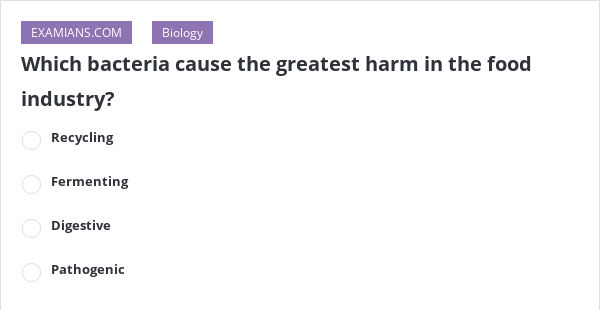
The food industry is inherently complex, characterized by intricate processes that extend from farm to table. Among the myriad challenges faced, bacterial contamination stands as a pervasive concern, with specific pathogens implicated in numerous foodborne illnesses. This article will elucidate the bacteria that inflict the greatest harm within this domain, particularly focusing on the mechanisms of their pathogenicity and the potential consequences for public health.
The prevalence of bacteria in food production is an inevitable reality. Bacteria thrive in diverse environments, often entering the food supply chain through various vectors. From livestock to produce, the risk of contamination remains omnipresent. A plethora of bacterial species can cause foodborne illnesses; however, the following types are frequently highlighted due to their significant impact on consumer health.
Salmonella: One cannot discuss foodborne pathogens without mentioning Salmonella. This genus encompasses more than 2,500 serotypes, with Salmonella enterica being the most notable for human infections. Found predominantly in poultry, eggs, and occasionally in unprocessed meats, the bacteria can elicit severe gastrointestinal distress. The pathogenicity of Salmonella is primarily derived from its ability to invade intestinal epithelial cells, evading host immune responses. Symptoms typically arise within 6 to 72 hours post-exposure, manifesting as diarrhea, fever, and abdominal cramps. Moreover, the economic ramifications are severe, as outbreaks compel recalls, leading to substantial financial losses for producers.
Escherichia coli: Particularly the O157:H7 strain of Escherichia coli has garnered extensive attention due to its virulence. Apart from causing sporadic cases, it is often linked to large-scale outbreaks resulting from contaminated ground beef and fresh produce. E. coli O157:H7 produces a potent Shiga toxin, which can lead to severe complications such as hemolytic uremic syndrome (HUS). This condition is characterized by kidney failure and can be fatal, particularly in vulnerable populations such as children and the elderly. The bacteria’s resilience within the gastrointestinal tract exemplifies the challenges faced by food safety agencies in mitigating risk.
Listeria monocytogenes: Listeria, though less prevalent than Salmonella and E. coli, is noteworthy due to its unique ability to proliferate at refrigeration temperatures. Found in deli meats, unpasteurized dairy, and even certain ready-to-eat foods, Listeria monocytogenes poses a grave threat, particularly to immunocompromised individuals and pregnant women. The bacterium can traverse the placental barrier, leading to miscarriage or severe neonatal infections. The biofilm-forming abilities of Listeria within food processing environments underscore the difficulties in eradicating this pathogen from facilities.
Campylobacter: Frequently underestimated, Campylobacter species are among the leading causes of bacterial gastroenteritis worldwide. Often found in undercooked poultry, unpasteurized milk, and contaminated water, they can elicit symptoms such as diarrhea, fever, and abdominal pain. Although Campylobacter infections are generally self-limiting, complications such as reactive arthritis and Guillain-Barré syndrome can arise, contributing to its notoriety in the food safety landscape. The ecological versatility of Campylobacter, coupled with its ability to survive in harsh conditions, complicates prevention efforts.
Cronobacter sakazakii: While not traditionally associated with adult illnesses, Cronobacter sakazakii presents significant risks for infants, particularly those consuming powdered infant formula. The bacterium can lead to severe infections, including meningitis and sepsis. The survival of Cronobacter in dry environments and its sporadic presence in powdered formula necessitate rigorous adherence to safe preparation practices, an area where knowledge gaps can have dire consequences.
The impact of these bacteria extends beyond individual health concerns to encompass broader economic and social ramifications. Foodborne illnesses result in millions of cases each year, placing a strain on healthcare systems and incurring significant economic burdens. The costs associated with treatment, loss of productivity, and the repercussions for food businesses illustrate the multifaceted nature of this public health challenge.
Moreover, the globalized nature of the food supply chain exacerbates the risk of pathogen transmission. Contaminated products can rapidly traverse borders, leading to widespread outbreaks that are difficult to trace. Collaborative efforts among international food safety organizations are imperative to mitigate risks and enhance food safety protocols.
In conclusion, the food industry continually grapples with the shadow of bacterial contamination. Salmonella, E. coli O157:H7, Listeria monocytogenes, Campylobacter, and Cronobacter sakazakii each contribute distinct challenges to food safety frameworks. Vigilance, innovation, and adherence to robust food safety practices are paramount in combating these formidable pathogens. As our understanding of these bacteria deepens, so too must our commitment to safeguarding public health within the intricate tapestry of the food industry.
